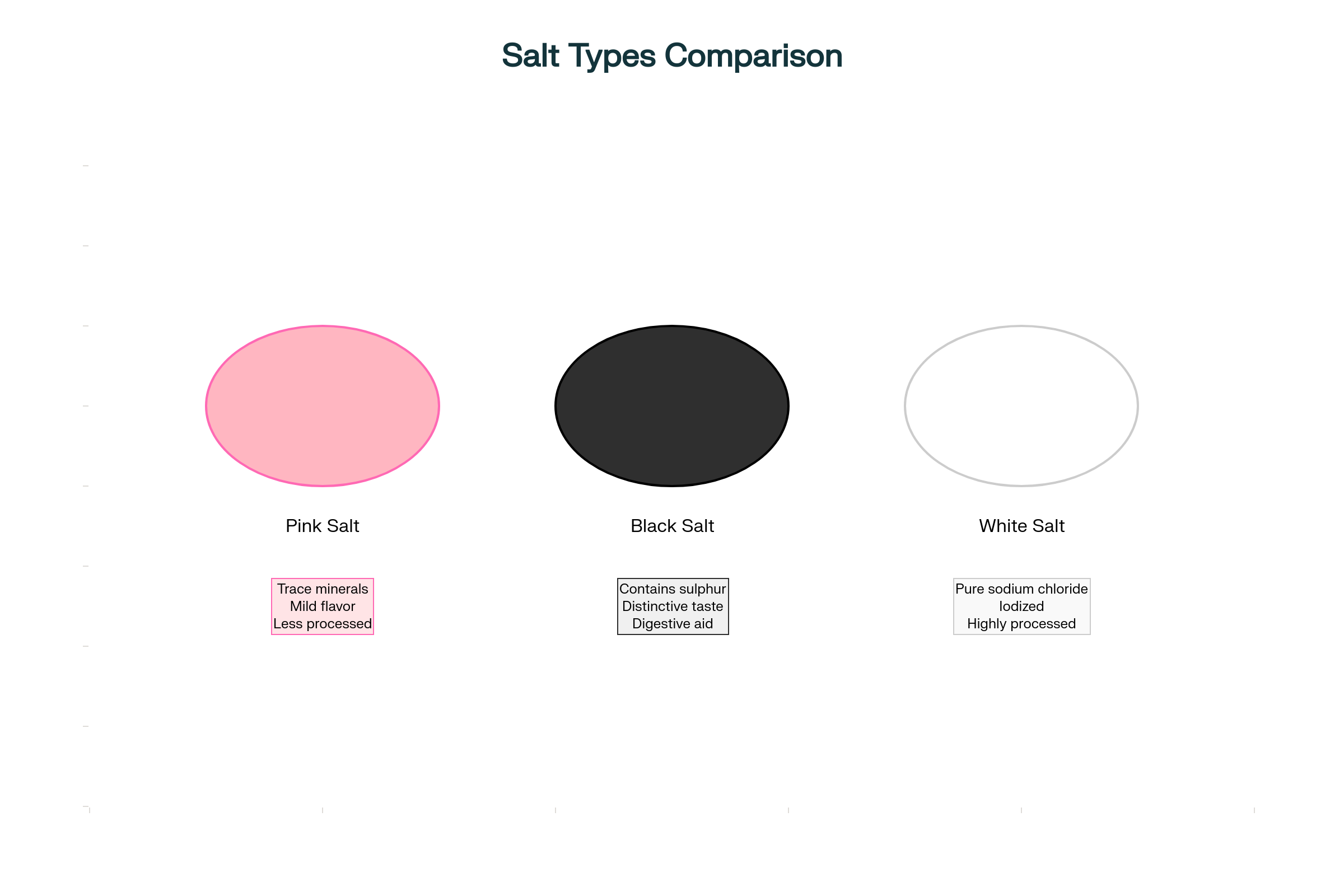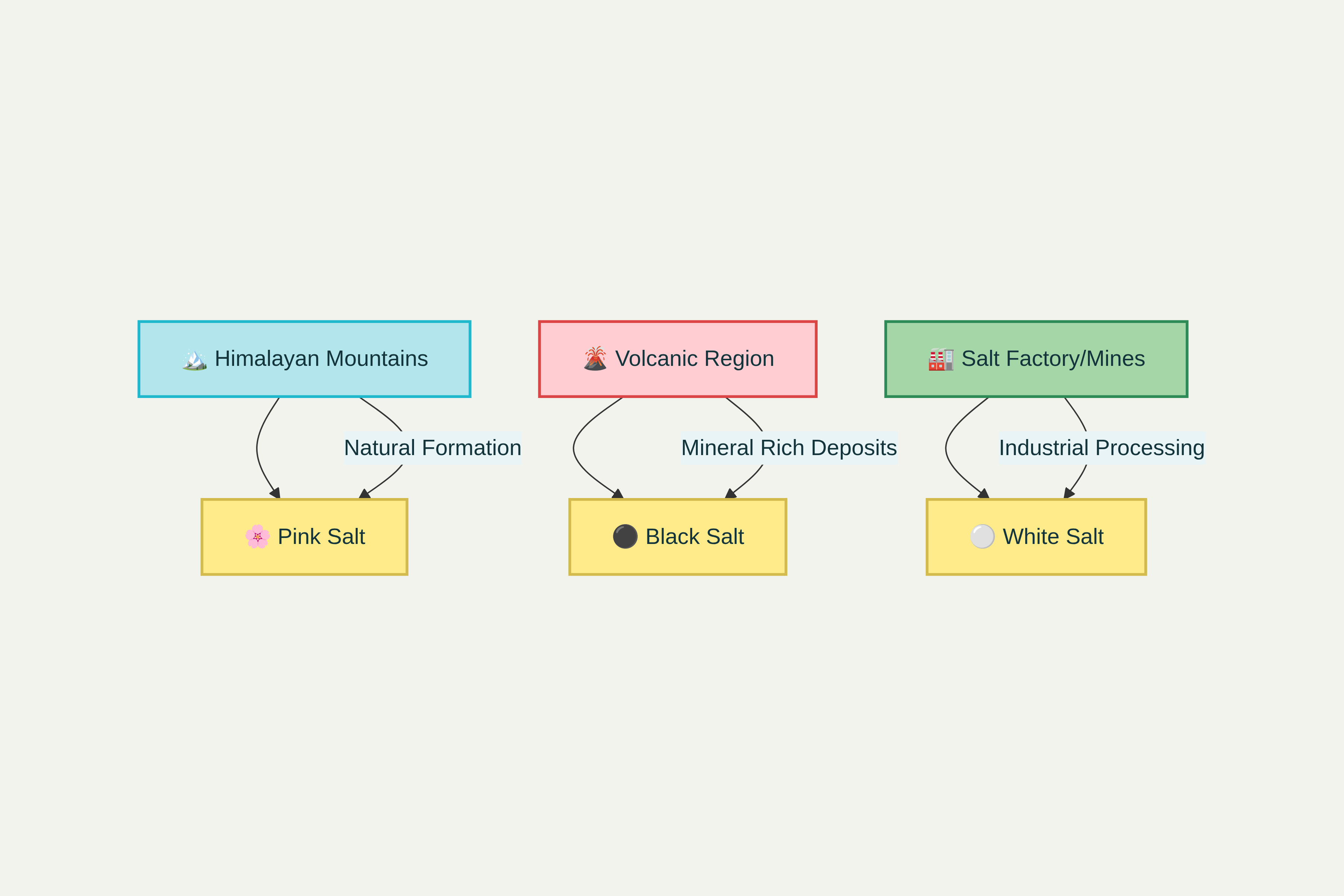Salt & Sensibility: A Colorful Kitchen Drama

Welcome to the most dramatic love triangle in your kitchen! Three salts, each with their own personality, backstory, and devoted fan following. Will our heroine (that's you) choose the mysterious pink mountain dweller, the sultry black volcanic rebel, or stick with the dependable white classic? Let the kitchen drama unfold!
Meet Our Leading Characters
- Pink Himalayan Salt: The exotic beauty with ancient mountain secrets. Born in Pakistan's salt mines, blessed with 80+ minerals, and Instagram's favorite child. Subtle, sophisticated, slightly less salty than her rivals. Think Jane Austen heroine with a mineral-rich personality!
- Black Salt (Kala Namak): The mysterious bad boy with a volcanic past and sulfurous charm. Smells like trouble (literally), tastes like heaven in your chaat. Ayurveda's favorite digestive sidekick. The Mr. Darcy of the salt world—misunderstood but irresistible!
- White Table Salt: The reliable best friend who's always been there. Processed, practical, iodine-fortified, and keeps your thyroid drama-free. Not flashy, but has saved more lives than both romantic leads combined!

The Plot Thickens: Health & Drama
- The Heart-Wrenching Truth: All three are high in sodium. Pink's "lower sodium" claim won't save you from that midnight pizza habit. Your heart doesn't care about the color—it cares about the quantity!
- The Thyroid Subplot: White salt's iodine is the unsung hero preventing goiter and thyroid disasters across India. Don't let the trendy alternatives steal this crucial scene!
- The Digestive Romance: Black salt and your stomach have the most genuine love story. That sulfur content genuinely helps with bloating and digestion—no acting required!
- The Mineral Mystery: Pink salt's trace minerals sound impressive until you realize you'd need to eat a mountain to get meaningful nutrition. It's seasoning, not a supplement!
⚠️ The Iodine Drama: A Health Reality Check
Here's the uncomfortable truth your wellness influencer won't tell you: Pink and black salts are NOT iodized. If you completely ditch white salt for trendy alternatives, you're risking iodine deficiency—and that's genuinely dangerous.
- What Happens: Iodine deficiency causes goiter (enlarged thyroid), hypothyroidism, fatigue, weight gain, and in pregnant women, severe developmental issues in babies.
- Why India Cares: We had widespread iodine deficiency until salt iodization became mandatory. This isn't paranoia—it's public health success!
- Who's at Risk: Pregnant women, children, vegetarians, and anyone living inland (away from iodine-rich coastal foods) who completely switches to non-iodized salts.
- The Reality: Unless you're eating seafood daily or taking iodine supplements, you NEED some iodized salt in your life.
🩺 The Blood Pressure Myth: Let's Get Real
The Myth: "White salt is dangerous for BP patients, but pink/black salts are safe." The Reality: This is dangerous nonsense that could literally kill people.
- The Science: High blood pressure is caused by SODIUM, not the color or source of salt. All salts are primarily sodium chloride—white salt ~97%, pink salt ~95%, black salt ~94%.
- The Numbers: Pink salt has marginally less sodium per gram, but the difference is so tiny (2-3%) that it's medically irrelevant. You'd need to eat pounds to see any benefit!
- Why This Myth Kills: BP patients who switch to "healthy" salts thinking they're safe often end up consuming MORE salt because they believe the marketing lies.
- What Doctors Actually Say: "Reduce ALL salt intake to under 1 teaspoon daily, regardless of color." Period. No exceptions.
- The Potassium Factor: Some claim pink/black salts have potassium that "balances" sodium. The amounts are negligible—eat a banana instead!
The Dramatic Resolution: Who Gets the Girl?
- For Everyday Romance: Pink salt wins with its gentle nature and mineral whispers. Perfect for the slow-burn, daily cooking relationship—but watch that quantity!
- For Passionate Encounters: Black salt brings the fire to Indian cuisine and digestive relief. When you need drama and flavor, this is your leading man—in moderation!
- For Reliable Partnership: White salt is the steady companion for baking, budget cooking, and thyroid health. Not flashy, but absolutely dependable—and just as "dangerous" as the others for BP patients!
- For Health Crises: Skip the salt drama and consult your doctor. When serious health issues are the plot, focus on medical advice, not marketing stories!
Breaking the Fourth Wall: Marketing vs Reality
Plot twist! The real villain in this story isn't any of our salt characters—it's the overhyped marketing claiming miracle powers AND the dangerous advice about BP safety. Pink salt won't detoxify your life, black salt isn't a cure-all, and NONE of them are safe for uncontrolled hypertension. The only "good" salt for BP patients is LESS salt, regardless of Instagram aesthetics!
The Happy (and Healthy) Ending
The smart move? A polyamorous relationship with all three, but respect the sodium limits your doctor sets. Use pink for daily cooking elegance, black for Indian cuisine passion, and keep white salt for thyroid protection—but measure them all with the same teaspoon! The real sensibility here? Understanding that your blood pressure meter doesn't care about marketing claims, and your health is worth more than trendy crystals!